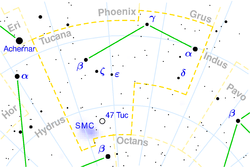Tucana
Tucana
Tucana is a constellation located in the southern sky. It was named after the Tucana bird, which is native to South America. Tucana is one of the 88 modern constellations recognized by the International Astronomical Union (IAU).
History
Tucana was first introduced by the Dutch astronomer Petrus Plancius in the late 16th century. It was later included in Johann Bayer's star atlas Uranometria in 1603. The constellation represents the toucan bird, which was unfamiliar to European astronomers at the time.
Features
Tucana is a relatively small constellation, occupying an area of about 295 square degrees. It is located in the fourth quadrant of the southern hemisphere and can be seen from latitudes between +25° and -90°. The constellation is bordered by other southern constellations including Hydrus, Phoenix, Grus, and Indus.
One of the notable features of Tucana is the Small Magellanic Cloud (SMC), a dwarf galaxy located approximately 200,000 light-years away from Earth. The SMC is one of the Milky Way's satellite galaxies and is visible to the naked eye from dark locations in the southern hemisphere.
Notable Stars
Tucana contains several notable stars, although none of them are particularly bright. The brightest star in the constellation is Alpha Tucanae, also known as α Tucanae or Al Tucanae. It is a binary star system located around 199 light-years away from Earth.
Another interesting star in Tucana is HD 81040, which is a yellow dwarf star similar to our Sun. It is known to have a planetary system, with at least one confirmed exoplanet orbiting around it.
Deep-Sky Objects
The Small Magellanic Cloud (SMC) is the most prominent deep-sky object in Tucana. It is a irregular dwarf galaxy that is gravitationally bound to the Milky Way. The SMC is home to numerous star clusters, nebulae, and other celestial objects.
One of the most famous objects in the SMC is the Tarantula Nebula (also known as 30 Doradus). It is one of the largest and most active star-forming regions in our local group of galaxies. The Tarantula Nebula is visible as a bright patch of gas and dust in the SMC.
Cultural Significance
In indigenous South American cultures, the toucan bird represented various symbolic meanings. It was often associated with beauty, agility, and adaptability. The constellation Tucana serves as a reminder of the rich cultural heritage of the region.
References
See Also
Transform your life with W8MD's budget GLP-1 injections from $125.
W8MD offers a medical weight loss program to lose weight in Philadelphia. Our physician-supervised medical weight loss provides:
- Most insurances accepted or discounted self-pay rates. We will obtain insurance prior authorizations if needed.
- Generic GLP1 weight loss injections from $125 for the starting dose.
- Also offer prescription weight loss medications including Phentermine, Qsymia, Diethylpropion, Contrave etc.
NYC weight loss doctor appointments
Start your NYC weight loss journey today at our NYC medical weight loss and Philadelphia medical weight loss clinics.
- Call 718-946-5500 to lose weight in NYC or for medical weight loss in Philadelphia 215-676-2334.
- Tags:NYC medical weight loss, Philadelphia lose weight Zepbound NYC, Budget GLP1 weight loss injections, Wegovy Philadelphia, Wegovy NYC, Philadelphia medical weight loss, Brookly weight loss and Wegovy NYC
|
WikiMD's Wellness Encyclopedia |
| Let Food Be Thy Medicine Medicine Thy Food - Hippocrates |
Medical Disclaimer: WikiMD is not a substitute for professional medical advice. The information on WikiMD is provided as an information resource only, may be incorrect, outdated or misleading, and is not to be used or relied on for any diagnostic or treatment purposes. Please consult your health care provider before making any healthcare decisions or for guidance about a specific medical condition. WikiMD expressly disclaims responsibility, and shall have no liability, for any damages, loss, injury, or liability whatsoever suffered as a result of your reliance on the information contained in this site. By visiting this site you agree to the foregoing terms and conditions, which may from time to time be changed or supplemented by WikiMD. If you do not agree to the foregoing terms and conditions, you should not enter or use this site. See full disclaimer.
Credits:Most images are courtesy of Wikimedia commons, and templates, categories Wikipedia, licensed under CC BY SA or similar.
Translate this page: - East Asian
中文,
日本,
한국어,
South Asian
हिन्दी,
தமிழ்,
తెలుగు,
Urdu,
ಕನ್ನಡ,
Southeast Asian
Indonesian,
Vietnamese,
Thai,
မြန်မာဘာသာ,
বাংলা
European
español,
Deutsch,
français,
Greek,
português do Brasil,
polski,
română,
русский,
Nederlands,
norsk,
svenska,
suomi,
Italian
Middle Eastern & African
عربى,
Turkish,
Persian,
Hebrew,
Afrikaans,
isiZulu,
Kiswahili,
Other
Bulgarian,
Hungarian,
Czech,
Swedish,
മലയാളം,
मराठी,
ਪੰਜਾਬੀ,
ગુજરાતી,
Portuguese,
Ukrainian
Contributors: Prab R. Tumpati, MD


